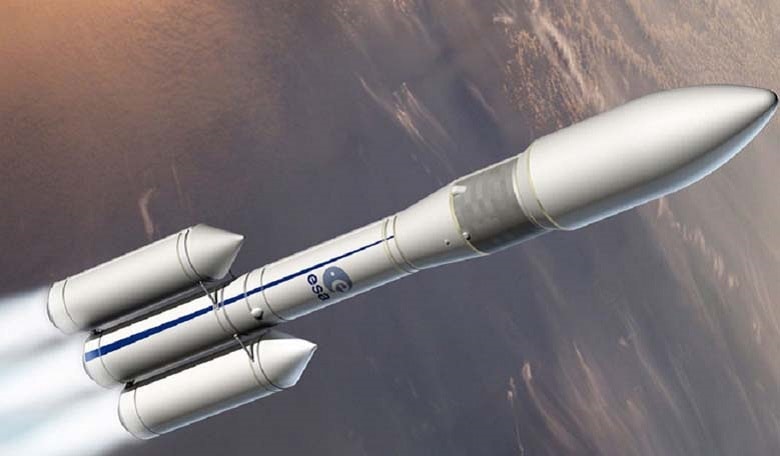The Council of Ministers of the European Space Agency (ESA) approved development of a new Ariane 6 rocket yesterday. As ESA Director General Jean-Jacques Dordain stressed, Ariane 6 is not just a new rocket, but a new governance model where industry accepts more of the risk. The ministers will have an opportunity at their next meeting in 2016 to relook at the program and decide if any changes are needed.
ESA is an international organization with 20 member countries (Austria, Belgium, Czech Republic, Denmark, Finland, France, Germany, Greece, Ireland, Italy, Luxembourg, the Netherlands, Norway, Poland, Portugal, Romania, Spain, Sweden, Switzerland and the United Kingdom) and one cooperating country (Canada).
The Council of Ministers, comprised of the top officials responsible for their country’s participation in ESA, meets every two or three years to determine what programs to pursue and how much money each member will contribute. ESA has “mandatory” programs to which all members must contribute (e.g. space science), while other programs are “optional” and countries participate only if they wish to (e.g. space transportation and the International Space Station).
Under its optional programs, ESA pays for the development of launch vehicles, while the French-based company Arianespace provides launch services using them. Arianespace’s current launch fleet consists of Ariane 5 for large payloads, the Russian-built Soyuz for medium payloads, and the European Vega for small payloads.
Ariane 5 is very reliable, but Europe has been debating for years what changes are needed to ensure Ariane and other European rockets can meet future market demands, especially lower prices spurred by competition from SpaceX.
Germany preferred an evolution of Ariane 5 (Ariane 5 ME) while France advocated a new Ariane 6 “family” of launchers with two versions: one for large payloads and one for medium payloads. Just prior to the ministerial meeting, Germany agreed to support the Ariane 6 proposal. Meanwhile, the ministers also agreed to develop an upgraded version of Vega. Ariane 6 and the new Vega-C will share the same first stage and thus all of Europe’s launch vehicles will “have the same DNA,” Dordain explained at a press conference after the meeting. That should reduce costs through simplified manufacturing and launch operations.
A key aspect of the Ariane 6 decision is that industry will take on some of the financial risk instead of it resting with the governments. Earlier this year, the two primary companies that manufacture Ariane, Airbus and Safran, announced they would form a joint venture, Airbus Safran Launchers, to participate in Ariane 6.
The resolution adopted by the ESA Ministers states that ‘the Joint Venture will bear all commercial market risks during exploitation without support from Member States” while ESA provides a guaranteed “institutional” market of five launches per year. Those launches would be for ESA itself, its member governments, the European Union (EU), and Europe’s meteorological agency, EUMETSAT. The joint venture will be responsible for finding any additional customers. It will also have the design authority for Ariane 6, rather than ESA.
In a press release today, Airbus and Safran said they welcomed ESA’s approval of Ariane 6, but added that their decision to create the Joint Venture (JV) “naturally assumes an in-principle agreement for the transfer to the JV of shares in Arianespace held by” the French space agency, CNES. A decision on that issue has not yet been made. CNES owns 34.68 percent of Arianespace. The remainder is owned in varying amounts by 20 European entities, including Safran and Airbus (Astrium is part of Airbus).
Dordain said he foresees no difficulty in delivering five institutional launches per year. The EU, for example, is launching a navigation satellite system, Galileo, similar to the U.S GPS system, that requires 24 operational satellites (plus in-orbit spares), which should guarantee a continuing demand for launch services.
Dordain said that at yesterday's meeting ministers committed €4 billion for the development of Ariane 6 and Vega-C, which is enough to pay for their development through first launch (Vega-C in 2018, Ariane 6 in 2020). He added, however, that they will have an opportunity to relook at the program at the next ministerial council in 2016: “Participating states … will decide to continue Ariane 6 on the same track or to change it once again, but we have commitments to take Ariane 6 to its maiden flight. …. We will be able to sign contracts until the end of the development phase.”
At today's exchange rate, 1 Euro is $1.23, so the €4 billion commitment for Ariane 6 and Vega-C is approximately $5 billion.











